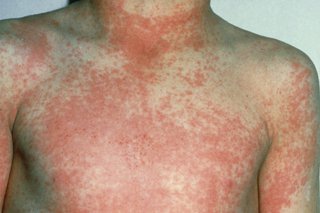Scarlet fever
Scarlet fever is a contagious infection that mostly affects young children. It's easily treated with antibiotics.
Check if you have scarlet fever
The first signs of scarlet fever can be flu-like symptoms, including a high temperature of 38C or above, a sore throat and swollen neck glands (a large lump on the side of your neck).
A rash appears a few days later.



The symptoms are the same for children and adults, although scarlet fever is much rarer in adults.
See a GP if you or your child:
- have scarlet fever symptoms
- do not get better in a week (after seeing a GP), especially if your child has recently had chickenpox
- are ill again weeks after scarlet fever has cleared up – this can be a sign of a complication, such as rheumatic fever
- are feeling unwell and have been in contact with someone who has scarlet fever
Scarlet fever is very infectious. Check with a GP before you go in. They may suggest a phone consultation.
What happens at your appointment
GPs can often diagnose scarlet fever by looking at the tongue and rash.
Sometimes they may:
- wipe a cotton bud around the back of the throat to test for bacteria
- arrange a blood test
Treating scarlet fever
Your GP will prescribe antibiotics. These will:
- help you get better quicker
- reduce the risk of serious illnesses, such as pneumonia
- make it less likely that you'll pass the infection on to someone else
Important
Keep taking the antibiotics until they're finished, even if you feel better.
Things you can do yourself
You can relieve symptoms of scarlet fever by:
- drinking cool fluids
- eating soft foods if you have a sore throat
- taking painkillers like paracetamol to bring down a temperature (do not give aspirin to children under 16)
- using calamine lotion or antihistamine tablets to stop itching
How long scarlet fever lasts
Scarlet fever lasts for around a week.
You're infectious up to 7 days before the symptoms start until 24 hours after you take the first antibiotic tablets.
People who do not take antibiotics can be infectious for 2 to 3 weeks after symptoms start.
Important
Children with scarlet fever should stay off nursery or school for 24 hours after starting antibiotics or, if not on antibiotics, until their fever is gone.
Is scarlet fever dangerous?
In the past, scarlet fever was a serious illness, but antibiotics mean it's now less common and easier to treat.
Cases of scarlet fever have increased in recent years. Public Health England records the number of scarlet fever infections each year.
Complications are rare. They can happen in the weeks after the infection as well as during it, and can include:
- ear infection
- throat abscess
- sinusitis
- pneumonia
- meningitis
- rheumatic fever
Pregnancy advice
There's no evidence to suggest that getting scarlet fever during pregnancy will harm your baby.
But it can make you feel unwell, so it's best to avoid close contact with anyone who has it.
Contact a GP if you do get symptoms.
The antibiotics used for scarlet fever are usually safe to take during pregnancy.
How to avoid spreading scarlet fever
Scarlet fever is very infectious and can easily spread to other people.
To reduce the risk of spreading scarlet fever:
Do
- wash hands often with soap and warm water
- use tissues to trap germs from coughs or sneezes
- bin used tissues as quickly as possible
Don't
- do not share cutlery, cups, towels, clothes, bedding or baths